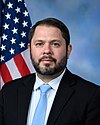
Coconino County is a county in the north-central part of the U.S. state of Arizona. Its population was 145,101 at the 2020 census. The county seat is Flagstaff. The county takes its name from Cohonino, a name applied to the Havasupai people. It is the second-largest county by area in the contiguous United States, behind San Bernardino County, California. It has 18,661 sq mi (48,300 km2), or 16.4% of Arizona's total area, and is larger than the nine smallest states in the U.S.

Maricopa County is in the south-central part of the U.S. state of Arizona. As of the 2020 census the population was 4,420,568, or about 62% of the state's total, making it the fourth-most populous county in the United States and the most populous county in Arizona, and making Arizona one of the nation's most centralized states. The county seat is Phoenix, the state capital and fifth-most populous city in the United States.

Navajo County is in the northern part of the U.S. state of Arizona. As of the 2020 census, its population was 106,717. The county seat is Holbrook.
Indigenous peoples of Arizona are the Native American people of the state of Arizona. These include people that have lived in the region since time immemorial, tribes who entered the region centuries ago, such as the Southern Athabascan peoples, and the Pascua Yaqui, who settled Arizona en masse in the early 20th century.

Texas's 7th congressional district of the United States House of Representatives comprises a small area of southwestern Houston and Harris County, along with a northern portion of suburban Fort Bend County. As of the 2000 census, the 7th district comprises 651,620 people. Since 2019, it has been represented by Democrat Lizzie Fletcher.

Texas's 8th congressional district of the United States House of Representatives includes all of Walker, Montgomery and San Jacinto counties, and parts of Harris County. It includes much of the northern outlying areas of metro Houston, including Conroe, Magnolia, and most of Lake Livingston. The current Representative from the 8th district is Morgan Luttrell and has been since 2023.
Arizona's 1st congressional district is a congressional district located in the U.S. state of Arizona, covering northeastern Maricopa County. Before 2023, geographically, it was the eleventh-largest congressional district in the country and included much of the state outside the Phoenix and Tucson metropolitan areas. From 2013 through 2022, it also included the Navajo Nation, the Hopi reservation, and the Gila River Indian Community, with 25% of the population being Native American. At that time, the district had more Native Americans than any other congressional district in the United States. In the 2022 elections, David Schweikert was elected in the redefined district. It was one of 18 districts that would have voted for Joe Biden in the 2020 presidential election had they existed in their current configuration while being won or held by a Republican in 2022.
Arizona's 8th congressional district is a congressional district located in the U.S. state of Arizona. It includes many of the suburbs north and west of Phoenix, in Maricopa County, Arizona. The district includes several high-income retirement communities, including Sun City West.
Arizona's 7th congressional district is a congressional district located in the U.S. state of Arizona. The district stretches along the Mexico–United States border and includes the western third of Tucson, parts of Yuma and Nogales, as well as Avondale and Tolleson in Metro Phoenix. It is currently represented by Democrat Raúl Grijalva.
Arizona's 6th congressional district is a congressional district located in the U.S. state of Arizona and encompasses all of Greenlee County, most of Cochise County, and parts of Pima County, Pinal County and Graham County. Most of its population resides in suburbs of Tucson, including Oro Valley, Marana, Green Valley, and Vail. The district is currently represented by Republican Juan Ciscomani. It was one of 18 districts that would have voted for Joe Biden in the 2020 presidential election had they existed in their current configuration while being won or held by a Republican in 2022.

The Colorado River Indian Tribes is a federally recognized tribe consisting of the four distinct ethnic groups associated with the Colorado River Indian Reservation: the Mohave, Chemehuevi, Hopi, and Navajo. The tribe has about 4,277 enrolled members. A total population of 9,485 currently resides within the tribal reservation according to the 2012-2016 American Community Survey data.
Arizona's 5th congressional district is a congressional district located in the U.S. state of Arizona, currently represented by Republican Andy Biggs.
Arizona's 4th congressional district is a congressional district located in the U.S. state of Arizona. It is currently represented by Democrat Greg Stanton. The district is located entirely within Maricopa County.
Arizona's 2nd congressional district is a congressional district located in the U.S. state of Arizona. The district is in the north eastern part of the state and includes Apache, Coconino, Gila, Navajo, and Yavapai counties in their entirety and portions of Graham, Maricopa, Mohave, and Pinal counties. The largest city in the district is Flagstaff.
New York's 15th congressional district for the United States House of Representatives is located in New York City, State of New York. The district has been represented by Democrat Ritchie Torres since 2021.

Florida's 4th congressional district is a congressional district in northeastern Florida, encompassing Nassau and Clay counties and part of Duval County. The district is currently represented by Aaron Bean of the Republican Party.
Arizona's 9th congressional district was created as a result of the 2010 census. The first candidates ran in the 2012 House elections, and the first representative was seated for the 113th Congress in 2013. Formerly located in the Phoenix area, the 9th district has been in western Arizona since 2023.

The 2012 United States House of Representatives elections in Arizona were held on Tuesday, November 6, 2012, to elect the nine U.S. representatives from the state, one from each of the state's nine congressional districts, including the newly created 9th district following the 2010 United States census. The elections coincided with other federal and state elections, including a quadrennial presidential election, and a U.S. Senate election. Primary elections were held on August 28, 2012.

Texas's 38th congressional district is a congressional district in Texas, covering parts of Harris County. It includes the Houston suburbs of Jersey Village, Cypress, Tomball, Katy, and Klein. The Memorial Villages and a portion of the city of Houston are also located within the district.




















